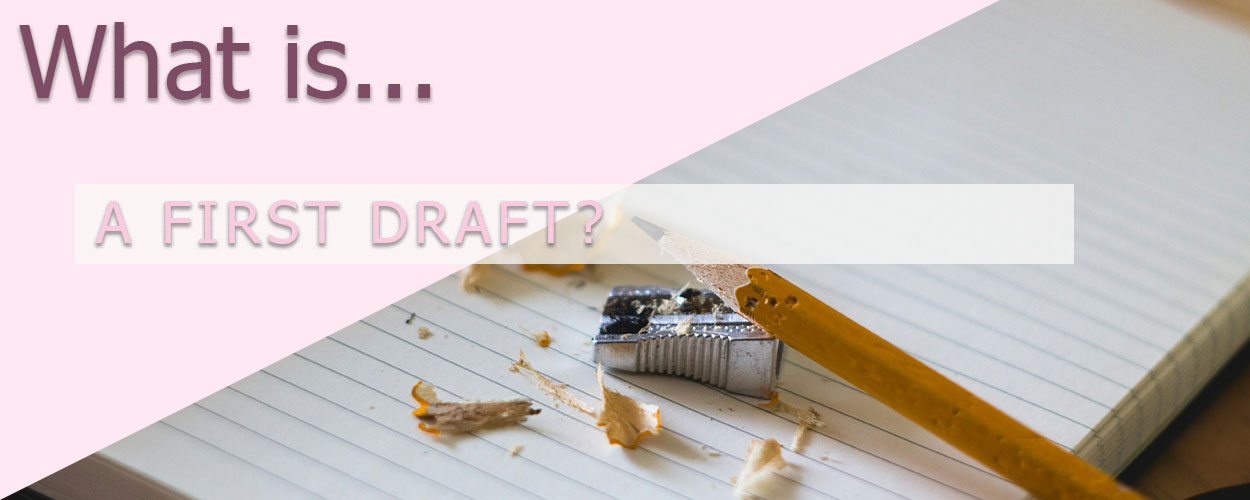

Posted: April 18, 2023
You probably already know this; a first draft is the first completed manuscript of a book, what’s done before the editing process begins. Simple, right? Well, I’m about to go further into detail.
Firstly, the biggest mistake writers can make is trying to make their first draft perfect. Do not do this. It is impossible. There is no way that you can sit down and write a book from start to finish and publish it without editing. That’s just not how it’s done, even by authors like Neil Gaiman, Stephen King, Brandon Sanderson, and the like.
The First Draft is supposed to be messy. It’s supposed to have characters that may not be completely fleshed out, scenes that are left unfinished, and notes about research and expansion that needs to be done. You may be on the sixth draft of your story before it’s “ready to publish,” but for now, let’s focus on Draft One.
As I said, first drafts are messy, and you may even call it “draft zero” until all of your notes are addressed and your research is done. For the sake of simplicity in this article, we’re calling it the first draft.
There are two main methods of writing. The first of these is the Planner, someone who takes the time to outline their story and do preliminary research before they begin writing their first draft. This method helps avoid the plot fizzling out, or writing your characters into a situation they can’t get out of.
For a mind that prefers higher levels of organization, it reduces the stress of a blank page. It also allows the writer to surround themselves with the work they’ve already done on the book and maintain a higher level of consistency.
Not to say that this is the most useful method of writing. Some planners may plan indefinitely. They will procrastinate by giving themselves the excuse to add more research and more details to their outline. At some point, you will have to just sit down and start writing.
The second method is known in the community as a Panster – meaning someone who writes by the seat of their pants. These types of writers just sit down and start writing their stories, the future as much of a mystery to them as it is to everyone else. If they ever get stuck, there is the option to add, in brackets, “this happens, then this happens” and move on without actually writing a certain scene; this is still panster writing.
Pansters often have a set word count goal in mind for their sessions. They will do research for scenes, but usually only when it comes up in their writing, or even after the fact while they’re editing.
Using this method, they hardly run the risk of procrastinating by continually outlining their work, though they are still vulnerable to writer’s block and may sit and stare at the dreaded Blank Page of Death all the same.
Whichever of these methods you use, once your first draft is done, it’s just that: a first draft. No matter how much research you’ve done beforehand, or if you’ve finished each and every scene you’ve written, the book is still in its beginning stages, and will most likely go through several rounds of editing and rewriting before it’s ready.
The very first step after your book is written is to take a break, then reread it. Give yourself maybe a week or two before even looking at it again; you need a reprieve from the story. With this fresh eye, read your work and make notes to yourself. A good strategy is not to make the changes right away, but simply to point out what you should change from the perspective of a reader, not a writer. This is because what readers like to read is often different from what writers like to write. After that, go back through as a writer and apply those changes.
This process will continue again and again, whether by yourself [click here to learn more about Self-Editing], by beta readers [Related Article: Alpha, Beta, Editing, & ARC: The Difference], or by professional editors [click here to learn more about Working with an Editor].
In my opinion, the best way to improve your writing is to switch back and forth between being a writer and a reader. Write your story, take a break, then read and make notes. Then take another break before you go through it again as a writer and make the changes that are needed. Rinse and repeat. Asking for help from others is also a big plus because they’ll see things in your writing that you’re blind to. Maybe even join a local writer group. Interacting with like-minded people is a great way to motivate yourself not to give up on your writing.
Top 10 Tips for New Writers
Top 10 Tips for All Writers
Top 10 Tips for Writing Captivating Stories
Writing Good Characters
Writing Compelling Villains
Alpha, Beta, Editing, & ARC: The Difference
What is Plot? [writing]
What is Genre? [writing]
What is an Outline? [writing]
What is a Timeline? [writing]
What is Character Building? [writing]
What is Character Development? [writing]
What is Worldbuilding? [writing]
What is Beta Reading? [review reading — pre-launch]
Tigerpetal Press is a small book press dedicated to publishing local authors and poets.